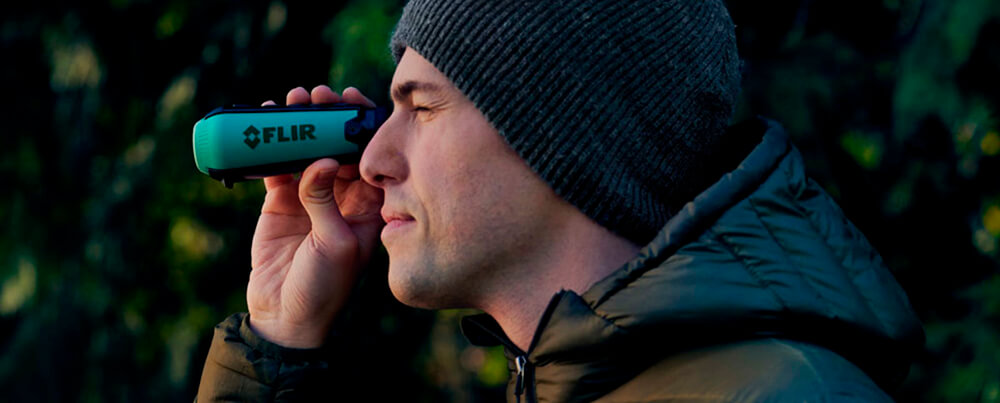
A monocular is a so-called compact telescope, an optical device for viewing long-distance objects with one eye. The best monocular can become an indispensable tool for a great variety of purposes like hiking, hunting, birding, etc.
In fact, its technical characteristics are similar to binoculars and telescopes, but its dimensions are much smaller. And this is its most competitive advantage: any monocular is small enough to fit in a handbag or even in a pocket. This is especially convenient for fishermen, tourists, and hunters who tend to carry a lot of equipment.
If you often find yourself thinking that it would be nice to see something on distance, it’s time to think about getting a monocular. So, if you have decided on buying the best monocular, make sure to get acquired with our top picks. If you have some questions, jump to our buyer’s guide. It will help you learn more about the basics of a monocular and will supply you with some information that you need to be aware of before making your buying decision.
Monocular Reviews
Authentic ROXANT Grip Scope Monocular

This model from ROXANT can be the best compact monocular. Having 5.5 x 2 x 2 inches of size dimensions, it can easily fit in your palm. Especially if you don’t mind having a monocular with only 6X magnification. Besides, since it’s not so powerful, it doesn’t prone to wobble at its highest magnification.
The device uses the high-quality optics: fully multi-coating and BAK4 Prism ALL Glass Lens (designed to reduce light scattering) to provide decent brightness so you could get a clear image at distance up to 300 feet. It has an anti-slip molded grip which provides less shake and it’s comfortable to hold in your hand.
As the monocular is designed for bird watching, hiking, boating, and hunting, it’s lightweight (7.8 ounces) and solidly built to withstand rough conditions. The device comes with a retractable eyecup (so you can use it with or without glasses), carry pouch with belt loop, cleaning cloth, and a neck strap.
Pros
- The focusing knob is located directly underneath the eyecup so you can easily use the device with one hand.
Cons
- It comes without a lens cap.
Gosky Titan 12X50 High Power Prism Monocular
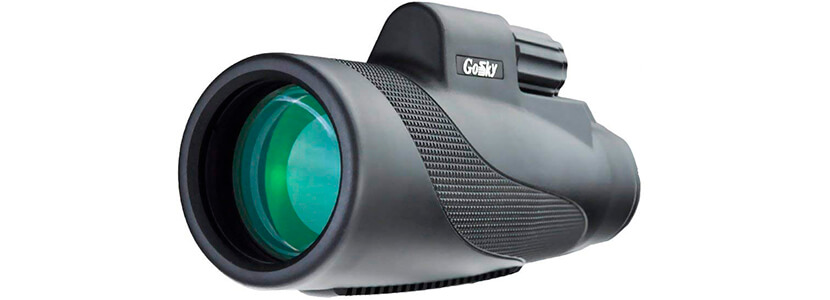
This monocular from Gosky has a solid framework and is made of a rubber armor designed to withstand tough weather conditions. Thanks to the 100% nitrogen-filled and O-ring sealed optics, the device is dust- and waterproof. It’s endowed with shock-absorbing and slip-resistant properties so it’s comfortable to hold the device in your hand.
This model can potentially be the best monocular for bird watching thanks to 6.5 degrees field angle which makes it easy to spot and track moving birds. Besides, it also has powerful magnification (12X) and is also suitable for hiking, hunting, climbing, sports games, etc. However, note that it’s not the lightest and the smallest monocular. It weighs 13.9 ounces and has 3.4 x 7.1 x 2.8 inches of size dimensions.
The Gosky Titan 12X50 has a light-gathering 50mm green film objective lens with fully multi-coating which provides a clear and bright image. The BAK-4 prism also guarantees brightness, good light transmission, and true-to-life color reproduction. The smart phase correction prism also minimizes glare and ghost images and reduces chromatic aberration.
It comes with a smartphone adapter which is compatible with almost all smartphones on the market and gives the opportunity to take videos and photos of whatever you see through the monocular. The device can be mounted on a tripod thought a standard tripod thread so you can free your hands while using a monocular.
Pros
- Has an adjustable eyecup twists.
- Comes with a carry bag, lens covers, cleaning cloth and straps.
Cons
- The phone mount is a bit confusing and takes some time to get it setup right.
Wingspan Optics Titan 12X50 High Powered Monocular Scope
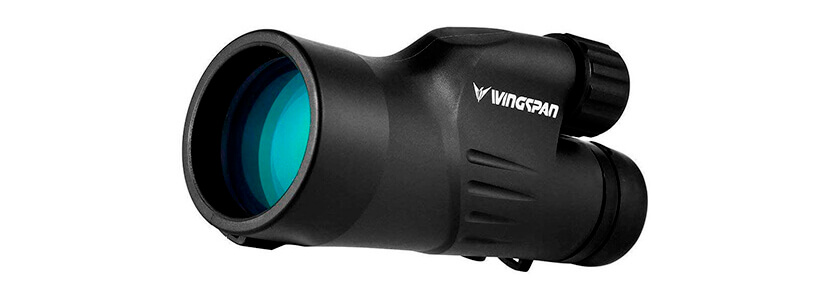
This model from Wingspan is probably the best monocular for hunting on our list. Thanks to the DiamondBright structural optics which ensures a high-quality image and correct clarity, you are less likely to lose your target. The wide field of view (246 feet) allows identifying the target quickly and accurately. It also has a fully multi-coated optical glass, BAK-4 prism type, and large 50mm lens. It’s a high power monocular as it offers 12X magnification.
Besides, the monocular is made of sturdy DuraArmor which is resistant to damages and won’t break if you accidentally drop it on solid ground. Additionally, it’s also a climate-proof model. You can use in the rain, fog, or near the water. It’s portable enough (3.1 x 1.9 x 6.4 inches) to take it whether you are going for a bird/nature watching or hunting.
You can use a monocular with the help of a tripod or with one hand as it offers one-handed access to the knobs.
It comes with the carrying case, eyepiece, and lens protection covers, together with the lens cleaning cloth made of a non-abrasive microfiber.
Pros
- The monocular has comfort grip design and an easy-access strap slot.
Cons
- With 14 ounces of weight, it can seem too heavy for someone.
Vortex Optics Solo Monoculars
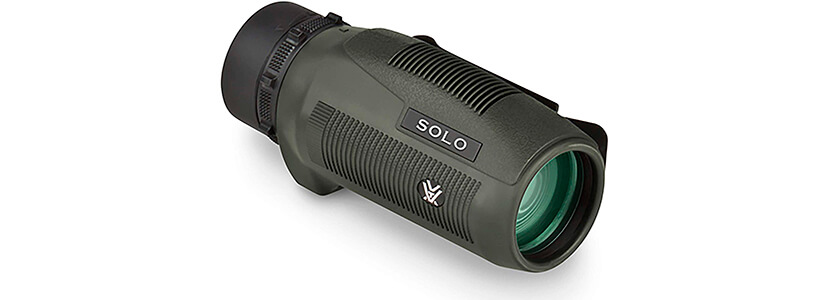
This Vortex monocular is designed for fishing, hunting, and nature watching. It features 8X magnification and a 36mm lens which provide a uniform, bright, and clear image.
The monocular is covered with a protective rubber coating and is comfortable to hold. You can also hold it using a lanyard that comes in the package. Besides, the unit comes with the utility clip so you can attach it to your equipment or clothing. The monocular is nitrogen purged so it’s protected from fogging of the optics during sudden temperature changes. The device is also an O-ring sealed which ensures protection against high humidity, fog, and dust.
This is a pocket monocular as it’s very small and quite light. It weighs 9.7 ounces and has only 4.88 x 2.17 x 2.36 inches of size dimensions.
Pros
- The adjustable eyecup is universal for viewing with or without glasses.
- The Vortex Optics Solo is equipped with a fully multi-coated glass.
- Comes with a soft case which provides an easy carry and protects the device when it’s not in use.
Cons
- The eyepiece is made of a cheap rubber which may quickly come off.
FLIR Scout TK Handheld Thermal Imager
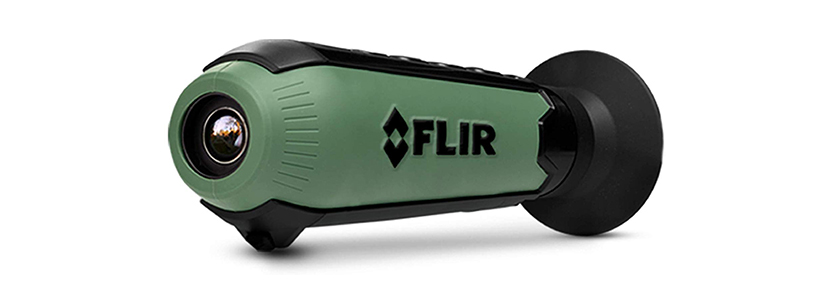
This Flir monocular is designed for a close-range work in low-light conditions and allows seeing objects over 300 feet away. It’s a pocket model as it’s extremely light (6.1 ounces) and small (6.7 x 2.3 x 2.4 inches). The device is powered by batteries which are charged with a USB cable. This monocular is submarine-shaped, goes in a rugged, weather-resistant case and has an IP67 waterproof rating which means that it’s totally submersible.
The device has 8 levels of display brightness and 8 thermal pallets. Additionally, there are possibilities to take photos and record videos.
This model can potentially be the best thermal monocular as it has a 12μm thermal sensor and a 640×480 LCD display. You can use it whether for surveillance and security purposes or for observing nature in low-light conditions.
Since it gives the ability to see heat signatures in total darkness, I can assert that this model can potentially be the best night vision monocular. However, note that it has quite low resolution (160×120).
Pros
- The device has only four control buttons and an initiative interface so it’s not confusing to use.
- Comes with a neck lanyard, USB cable, and lens cap.
- This infrared monocular also can work as an infrared camera.
Cons
- It doesn’t have magnification capabilities.
Wingspan Optics Nature 10X50 Wide View Monocular
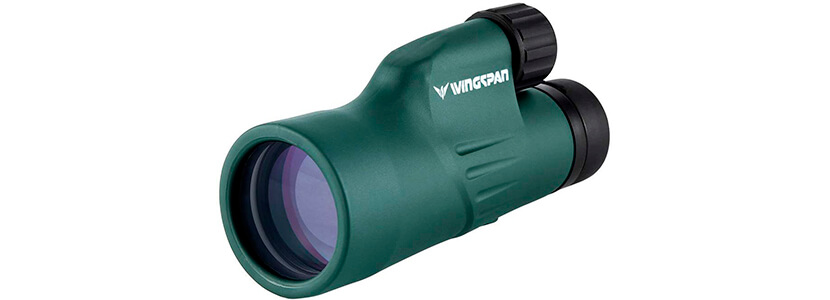
This high power monocular from Wingspan is perfect for birdwatching. It features powerful 10X50 magnification which allows seeing birds with increased detalization. With 304 feet field of view, you can quickly scan the landscapes to spot birds and wildlife. The 50mm objective lens is large enough to provide good image visibility and higher performance.
Besides, it’s durable enough to be used in different weather conditions. It has a rugged armor with the ability to lock-out moisture, dust, and debris, and also prevents internal fogging. Plus, it features an anti-slip grip.
It worth to be mentioned that this is definitely not a pocket-size monocular with 7.24 x 4.17 x 3.23 inches of size dimensions. With 14 ounces of weight it’s also not a light model.
The case, eyepiece, lens covers, and cleaning cloth come bundled in the package.
Pros
- Provides one hand focus.
- Good visibility at late nights and early mornings.
Cons
- It’s too heavy to be used with a compact tripod. A tall one is needed for this monocular.
Bushnell Legend Ultra HD Monocular
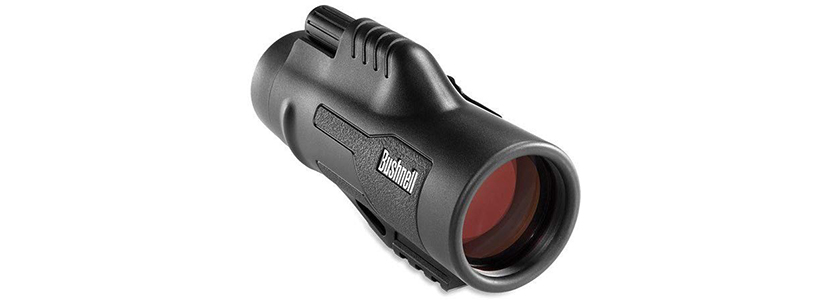
This Bushnell monocular features fully multi-coated optics and ED Prime Glass which reduces color dispersion. It has 10x magnification and 42mm objective which lets in plenty of light and provides crystal-clear images with great brightness. This also means that you can use the monocular at both daylight or low-light conditions. Thanks to the BAK-4 roof prism, the monocular ensures great quality images. Generally, it’s universal for tactical operations, sports events, concerts, hunting, etc.
Its construction is 100% waterproof and fog proof thanks to the RainGuard HD coating. The monocular’s case is armored with rubber which absorbs shock. You can carry it using a clip or a neck lanyard.
The 340 feet range field of view is enough to observe the object and the surroundings simultaneously. It also offers a close focus distance at 6.5 feet.
With 4 x 4.6 x 6.5 inches of size, it’s not among the light models. However, 10.4 ounces of weight doesn’t make the device too heavy.
Pros
- Features comfortable twist-up eyecups.
- Comes with Picatinny rail which allows attaching the device to firearms, tripods, or other mounts.
Cons
- The lens caps are made of hard plastic which can cause creases in the rubber armor.
Buyer’s Guide
What is a Monocular Used For?
The monocular can be used for:
Hiking and nature
Without any doubts, it’s hard to do without monocular when observing a wild nature. The monoculars used for this purpose have good magnification strength (10X-12X) so you could stay well-hidden when watching animals. A good monocular telescope for hiking must be durable so you could safely use it in different conditions.
Birding
The monoculars for birding don’t have powerful magnification as it can give you a shaky image which is not convenient when you are trying to observe the birds up close. It also has a wide field of view to spot and track moving birds. The large lens size (40-50mm) gives better brightness in heavily treed areas.
Hunting
The hunting monocular has a wide field of view and a large lens so the hunter could easily follow the target. As well as a monocular for hiking, a monocular for hunting must be sturdy to withstand harsh conditions.
Concerts and sports events
Such monoculars have wide field of view so you could see what is happening on the stage. They also don’t have too high magnification strength (not higher than 10X) and too wide lens as such events happen in well-lit areas.
Night viewing
The infrared monocular is used for night vision. It has a clearer image, less magnification power but larger lens size to provide a decent light-gathering in the dark. The simple models are used by non-professionals for security or for observing nature in the night time. The professionals use much more advanced night vision monocular GEN 3 which is a tactical multifunctional multi-purpose unit.
How to Use a Monocular?
Even the most powerful monocular won’t be very efficient if you don’t know how to use it properly. The monocular has several functions, but no matter which one of them you are going to use, you should remember to hold it firmly.
To look through the monocular in a proper way, follow these steps:
- Use an eye with better vision. Plus, if you have impaired vision you need to wear glasses. The monocular should lightly press against them.
- Bring the monocular to your eye. The lens shouldn’t touch your eye, but it should be as close to it as possible. Close the other eye to focus and fix the monocular by pressing your forefinger against your brow.
- Establish the focus. Rotate a ridged dial in different directions until you get a clear image.
To use a zoom monocular for tracing and tracking, follow the next steps:
- Locate the object. First, you need to determine the object that you would like to view. Keep an eye on this object — it will help you find it easier when you will use a monocular. However, if you still can’t find an object when you place the monocular to your eye, open your other eye to set the right direction.
- Follow your target. If you are viewing a moving object, you have to slowly turn your head to follow your target. If it moves a great distance, you should move your body as well. Remember not to move too fast, this may frighten your target off.
- Adjust the focus as target moves. Focus the lens in accordance with your target’s moves to keep it within an eyeshot.
- Don’t move. It’s not safe to move when the monocular is pressed against your eye. Don’t walk, run, or drive while you are using a monocular: it all can lead to an injury.
If you don’t know how to protect your monocular, you can break it very quickly. There are some simple rules that you need to follow if you want to provide longevity of your optic device:
- Attach a strap to your monocular. A special strap wrapped around your wrist or neck will protect your device from dropping and breaking. This is especially important when you use it in rough conditions or around water.
- Don’t let your monocular get wet. The waterproof monoculars are expensive, but there is another way to protect your device from water, keeping it in a zipped freezer bag. Just ensure that it’s completely sealed.
- Don’t forget to use a lens cap. It helps keep your lens clean and protects it from damage.
- Keep your monocular clean. Use a special cleaning cloth or an eyeglass wipe to clean the lens from time to time so you always have a clear view. Don’t use toilet paper or a t-shirt to clean the lens because they can leave scratches on its delicate surface.
How to Attach a Night Vision Monocular to a Scope?
A scope is an optic device used for an accurate sight. It can be used with any system that requires an accurate aiming, but most commonly found on rifles. The night vision monocular attached to a scope gives an advantage of more efficient viewing in low light conditions and is widely used by shooters and hunters. So if you want to attach a night vision monocular to a scope, carefully follow these steps:
- Read the scope mounting instructions before you start.
- Ensure that your rifle is unloaded before you start and point it only in safe directions.
- Fix the rifle in a gun vice.
- Mount the scope base with screws (make sure that they are of the right size) by tightening each one of them one by one.
- Fasten the rings to the base and tighten their screws in accordance with the instructions.
- Replace the upper half of the rings and tighten the screws.
- Adjust the monocular so it feels comfortable for your eyes and has a clear image.
How to Use Golf Rangefinder Monocular?
A golf rangefinder monocular is used by golf players for measuring yards between the hole and golf ball. There are marked lines inside the lens which help gauge the distance. Most of such monoculars measure in yards or meters.
To use a golf rangefinder monocular, first of all, stand on the fairway next to the ball and hold the device up to your eye. Align the bottom of the flagpole with a horizontal line marked as “Green” in your monocular. The numbers aligned with the top of the flagpole are your yardage. Then just choose a golf club corresponding to that distance.
If the flag base is obstructed and the course you are playing has striped flagpoles, align the bottom line to the golf course with the lowest visible stripe of the flagpole. Find the number aligned with the top of the flagpole.
Multiply the number of stripes you see on the flag by the number aligned with the top of a flagpole and divide by eight. Let’s suggest that you see 6 stripes and you have measured 160 yards in the monocular. Thus, the distance is 112.5. Note, that if the course you are playing doesn’t have striped flagpoles and you can’t see the pin base, the monocular won’t be accurate.
Don’t forget to clean your golf rangefinder monocular and blow out any visible dust from it after each round.
